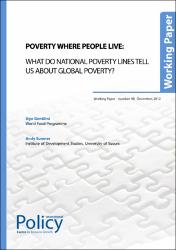Please use this identifier to cite or link to this item:
https://repositorio.ipea.gov.br/handle/11058/15567Full metadata record
| DC Field | Value | Language |
|---|---|---|
| dc.contributor.author | Gentilini, Ugo | |
| dc.contributor.author | Sumner, Andy | |
| dc.date.accessioned | 2024-10-04T00:00:22Z | - |
| dc.date.available | 2024-10-04T00:00:22Z | - |
| dc.date.issued | 2012 | |
| dc.identifier.uri | https://repositorio.ipea.gov.br/handle/11058/15567 | - |
| dc.description.abstract | Debate about national and international poverty measurement continued to evolve (see for example, Abu-Ismail et al., 2012). The basic question of how many poor people there are in the world generally assumes that poverty is measured according to international poverty lines (IPLs). Yet, an equally relevant question could be how many poor people there are in the world, based on how poverty is defined where those people live. In short, rather than a comparison based on monetary values, the latter question is germane to estimates based on a concept—‘poverty’—as defined by countries’ specific circumstances and institutions. (…) | en |
| dc.language.iso | en | |
| dc.title | Poverty Where People Live: What do National Poverty Lines Tell us about Global Poverty? | en |
| dc.type | Working Paper | |
| dc.rights.holder | International Policy Centre for Inclusive Growth | |
| dc.rights.holder | United Nations Development Programme | |
| dc.location.country | Brasil | |
| dc.description.physical | 39 p. : il. | |
| dc.rights.type | Licença total exclusiva | |
| dc.rights.license | O texto e dados desta publicação podem ser reproduzidos desde que as fontes sejam citadas. Reproduções com fins comerciais são proibidas. | |
| dc.subject.keyword | poverty | |
| dc.subject.keyword | national poverty lines | |
| dc.subject.keyword | global poverty | |
| ipea.access.type | Acesso Aberto | |
| ipea.researchfields | N/A | |
| ipea.classification | Desenvolvimento Social | |
| Appears in Collections: | Publicações do IPC-IG | |
Files in This Item:
| File | Description | Size | Format | |
|---|---|---|---|---|
| en_IPCWorkingPaper98.pdf | 1.22 MB | Adobe PDF |  View/Open |
Items in DSpace are protected by copyright, with all rights reserved, unless otherwise indicated.

